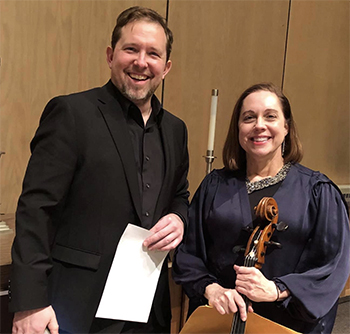by Nicholas Stevens

The continuous 90-minute program on Saturday, February 2 resembled a massive multi-authored symphony: a vigorous opener, a moment of introspection, an exercise in vitality, and a grand summation. As ever, Shaker Heights’ Plymouth Church sprang to vibrant life with this chamber orchestra on its dais. The program title, “Resonate Reinvention” — a reference to each featured composer’s repurposing of pre-existing material or past styles — felt apt in this acoustic environment.
Highlights arrived at the beginning and end. The orchestra played the opening bars of Golijov’s Siderius as though assembling a musical temple. Imposing blocks of sound, so reminiscent of Bruckner, yielded to cinematic swells that belied the group’s size. Excitement mounted as the trombones and tuba, onstage for this piece alone, helped build toward a thrilling climactic passage for full orchestra. The next section, notoriously interpolated from a piece by Golijov’s collaborator Michael Ward-Bergeman, found John Brndiar playing piccolo trumpet with pure, almost flute-like tone and astonishing precision, backed by section-mate David Duro.
Next came an actual composition by Bruckner, the Adagio from his Quintet in f in an arrangement for string section by Lucas Drew. Here as ever, Meyer proved a generously communicative leader, connecting with individual players and section leaders so effectively that the bold gestures implied by his movements seemed to pour directly from his hands. All of Bruckner’s characteristic gestures made appearances: ruminative silences, textures thinned to solo lines, and hymn-like simplicity juxtaposed with grand digression. The composer’s love of flat keys and harmonic wandering also apply in his Quintet. Such harmony, appropriate for Brucker’s organ and brass sections but somewhat less so for massed strings, bedeviled the otherwise spot-on players as they fought to coordinate their pitch.
Next came Vivaldi’s Concerto for two cellos, a workout for BlueWater’s Linda Atherton and Derek Snyder. The soloists offered contrast as they engaged in imitative duels, Atherton bringing a clean ring to high lines and Snyder a commitment to rhythmic drive below. Cellist Kent Collier remained in tight sync with his soloist section-mates, though his fellow continuo players sometimes seemed at odds with Meyer’s beat.
The concert concluded with a wonderful reading of Schubert’s Mozartean Symphony No. 5, inaugurated with fine work from oboists Martin Neubert and Cynthia Warren and bassoonists Phillip Austin and Mark DeMio. The harmonic surprises and graceful melodies of the first movement paved the way for those of the second, which swept along at just the right tempo. Hornists Ken Wadenpfuhl and Sean Yancer harmonized in pure, soaring tone in the trio section of the third movement, and concertmaster Emily Cornelius helped rally the upper strings for a rousing tour through the finale.
Published on ClevelandClassical.com February 11, 2019.
Click here for a printable copy of this article



